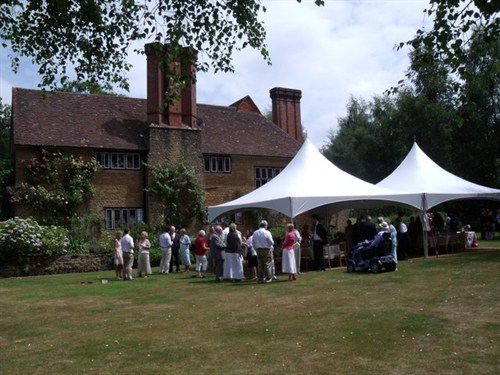An interesting and enjoyable month
Monday, February 4, 2013
January can often be a long and depressing month, but this
year it seems to have flown by. We must have been one of the few
places in the UK in January that had little snow on the ground and
although we had 18 nights of frosts none of them was
severe.
How green was our valley? We are right at the bottom of
the snowfields - you can just see the poytunnels in the centre
picture. This on the day that many places in Wales were still cut
off.
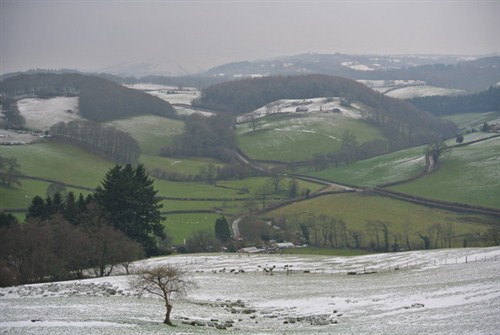
I was able to do a good deal of work outside including the
annual early battle with the bittercress; some was already showing
flower buds and if you don't catch them now there will be even more
to pull out later in the year.
How green are our borders? Bittercress as far as the eye
can see!
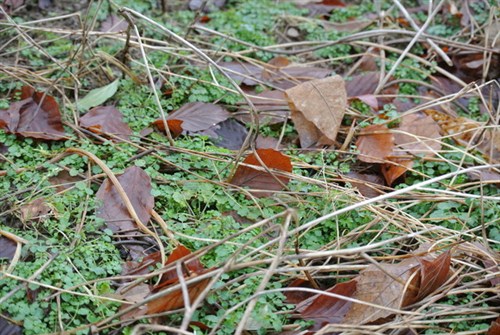
It was good to have made this early progress and to begin seed
sowing in the propagation tunnel. I said I was going to cut back
this year but as always the catelogues and lists from the plant
societies I belong have seduced me. If I keep the number of packets
of seeds to be sown below 300 I will have done well - but don't
count on it!!
I will update this pic over the next few month so you
can see how the hot bench fills up. 120 pots sown already! Some
since the pic was taken.

Weather
A really mixed bag of weather. Apart from snow and frost there
was thunder and lightning, bizzarely in a snowstorm, some warmer
days with a glimpse or two of sunshine - remember what that is
like? - and the obligatory wind and rain. The ground just never
dries out and the fields all around are holding more water that I
have ever seen in the 37 years I have lived here. Min -6C Max
13C
Garden Update
The days are noticeably getting longer and the season is more
advanced than ln the last 4 years. Many of the hardy perennials are
showing new growth in the crowns and there are swelling buds on
some shrubs particularly elders and hydrangeas. The cornus mas is
already in flower with it's showy yellow flowers to be followed
later by red "cherries" which are edible but the stone is much
larger than the flesh! It's common name is the Cornelian
Cherry.Roses too are growing away strongly.
I will need to be busy in February with cutting down all the
dead stems on the herbaceous plants and cutting back to a couple of
buds all the clematis that come into flower from mid June onwards
(Group 3 clematis). You don't have to do this of course but it
produces vigorous growth from the base and keeps the flowers at a
lower level where they can be more readily enjoyed. However those
growing up large trees can generally left to their own devices to
cascade down their host. At pruning time I will make a a generous
application of fish blood and bone fertiliser to see them through
the early part of their growing season followed in June by a feed
of well rotted manure.
I have begun to pot on and divide plants in the nursery and
already the frames are full and space is running out in the
tunnels. It's going to be fun in the next few months to find room
for all the developing seedlings!
Having lost two of my oldest Koi carp last year (I acquired them
in 1992) I am treating the water with salt water at a rate of half
an ounce a gallon to kill off some of the parasites and diseases
that build up in a long established Koi pond. I add the salt gently
over a 6 week period until maximum concentration is achieved. I
have found that it also has a benficial effect in reducing the
early onset of blanketweed when the water begins to warm up in
April (we hope!)
What's looking good?
I think the event I look forward to most of all in my gardening
year is the first flowerings of my beloved hellebores, jewels of
almost every hue scattered in the otherwise bare earth in the
depths of winter. This year they are very early - a few were in
flower even before Christmas. Christopher Lloyd was once asked by a
visitor to Great Dixter what was his favourite plant. He had no
hesitation in answering that it was the plant he happened to be
looking at. I fully understand what he meant because there is so
much to delight us at all times of the year, but if pressed I would
have to say it would be hellebores for me. Bone hardy, long lived (
I still have the one that was in the garden in 1976 that started my
love affair with them) There are now well over 200 all over
the gardens. Some of my best froms are reserved for the Spring
Garden along the Beech Hedge walk. They are very clean this year
with little blackspot and have grown well with all the rain last
year producing abundant flower buds.
A selection of some of the better flowers
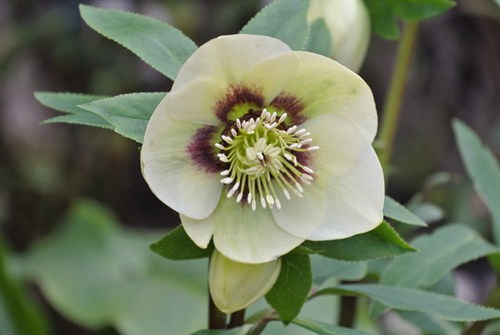
A lovely simple green coloured flowered plant with the
most perfect cup shaped outward facing bloom typical of those bred
by the Hellebore Queen Helen Ballard in the 1970's and
80's
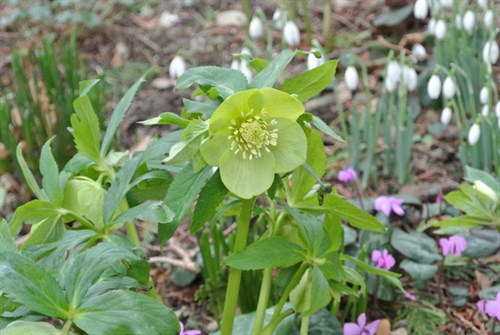
A more recent acquisition from the Alpine Garden
Society's early spring show last February. The most stunning and
unusual flowers with petaloid nectaries (the centre rosette).
The form is called anemone centred but it is unique in my
experience. It was named as a torquatus hybrid. As you can guess it
really excites me.
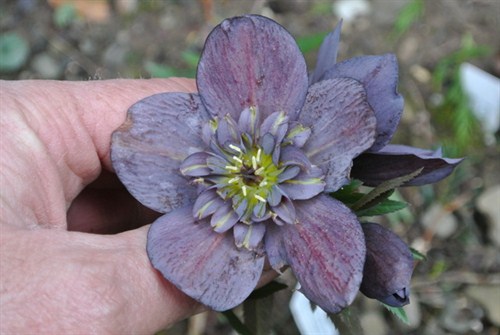
Companions to the hellebores are snowdrops now showing well and
some great stands of cyclamen coum which are particularly
floriferous at the moment with plenty still to come.
Tough as old boots with delicate flowers and wonderfully
marbled leaves cyclamen coum are a must for the early spring
garden.
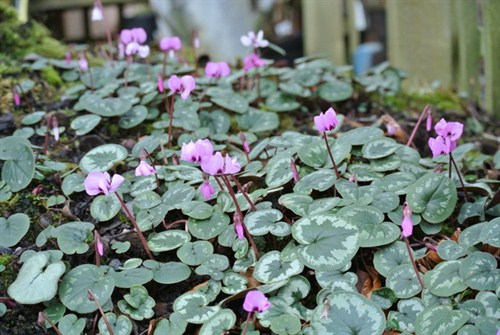
There are pulmonarias too showing colour in the bud and a few
primroses. In the tunnels a couple of exotics are in flower notably
the acacia baileyana Purpurea and a couple of gorgeous zantedescia
aethiopica. Usually white there are some good coloured cultivars
including a delicate pink one I acquired last year called "Pink
Flamingo". I also have 1 year old seedlings of an unusual form
called pentlandii which has golden yellow flowers - what
would I do without Chiltern Seeds? I can't wait to see it flower in
a couple of years time.
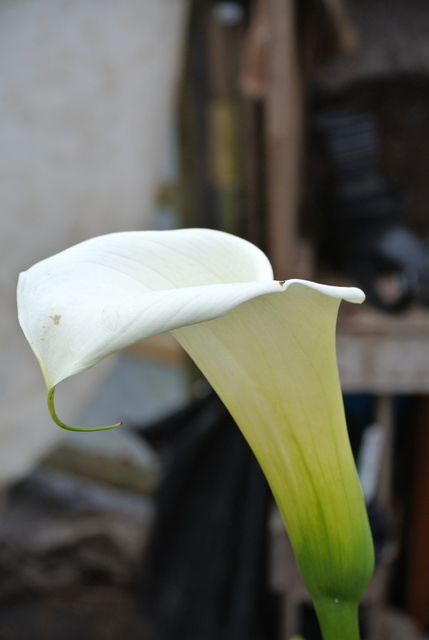
The exquisite pale pink "Flamingo" Shame about the slug
hole in the tip of the flower! There is a good seed pod on this
plant so it will be interesting to see what the colours of the
progeny will be in a few years time.
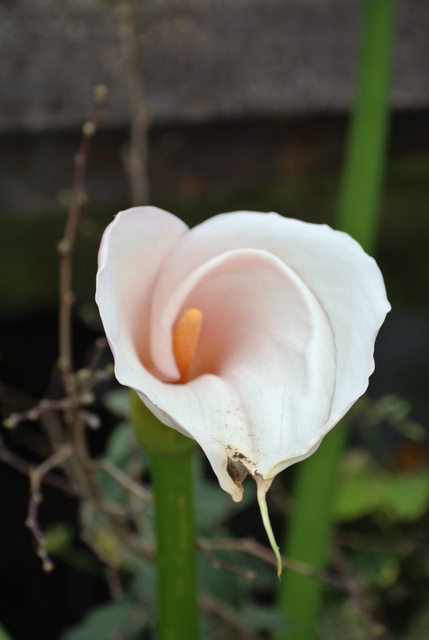
Finally a word for my maligned and sorely tested vegetables that
generally hated 2012. We have some very good cabbages particularly
the very hardy form called "Tundra" and have been picking sprouts
since September. The variety called "Brilliant" has lived up to its
name as always and has just come to an end. We have recently stared
to crop a late variety called "Titus" which has huge sprouts on
relatively short plants which unfortunately makes easy grazing for
rabbits! Leeks have enjoyed the rain and there are plenty of large
ones to harvest. There are still a few chillis and sweet peppers in
the tunnel and we finished our last tomatoes from 2 varieties
direct from the vines, on 9 January still tasting wonderful.
The incredible "Rosada" that cropped on it's 13 truss and a
standard sized form "Premio" for eating sliced in a salad or baked
whole in the oven with a drizzle of olive oil and balsamico. It is
very difficult to go back to buying tomatoes now!
Wildlife and countryside
The highlight of the month was the first sighting for many years
of a pair of lapwings in the field opposite the Lodge. They
betrayed their arrival with their characteristic "pee-wit" call.
Lovely medium sized, blackish birds with white underparts and
unmistakable rounded wings. They spend their winters on foreshores
and estuaries and return to upland countryside to nest on the
ground in fields and meadows. They were a common sight here in the
1970's and 80's together with curlews who share a similar habitat,
but improved drainage and changing agricultural practices like the
arly cropping of silage, means there are less suitable habitats for
nesting. It would be lovely to welcome them and the curlews back to
their former spring homes.
Staying with birds the robins are still constant companions. No
sign of them until you step out into the garden and you then you
turn around and there they are under your feet (but only ever one
at a time) dodging whatever implement you happen to be
wielding to devour a juicy morsal. They can also be trained to help
with the garden chores! Check this out!!
With his keen eyesight (he can spot the smallest morsel
of food from 10 metres) this robin has been trained to read the
faded plant labels and report back to me so that the label can be
re-written! In time he will be able to write the label
himself!!

Red kites are now so common here they vastly outnumber the
buzzards that used to be the main raptor. Always resident in this
part of Wales it was their last refuge 30 years ago when their
numbers had dwindled to less than 20 breeding pairs. They have now
been introduced or spread out naturally to other parts of the UK
and it was an unexpected event when travelling down the M4 corridor
through Berkshire and Wiltshire to see good numbers of them soaring
and swoouping over the snow covered motorway verges.
On the continuing subject of sheep from previous news articles,
the rams have done their stuff and their progeny are just a few
weeks away from being born They now spend their days separated from
the rest of their flocks at idle leisure, ganging up on walkers
with malicous intent (they are quite harmless - just
hungry).
The black faced ram is a pedigree Suffolk and the others
pedigree Charolais. The one on the far right is huge - above waist
height on me.

Visits
We went to Godalming in Surrey mid month (more on this later)
and to the Cotswolds last week but were just a little early for the
main flush of snowdrops in the famous gardens that are dotted
around the area.
February sees the resumption of the winter talks season with
talks on the Gower, in Swansea and West Wales. There is also the
annual Winter Gardening Weekend in Llandysul from 22 - 24 February
inclusive Go to www.llandysul -
ponttyweli.co.uk for more details. I will be speaking on the
Saturday at 12.15 and after lunch as a panel member in a Question
Time which is always fun. If you can come along it would be great
to say hello!
Back to Godalming. I have always said how lucky we are to live
in this wonderful part of Wales and to have such good neighbours.
Our nearest neighbours, Sir Robert and Lady Clark have had a
holiday home here for 25 years and we have come to know them well.
Having been a disciple of Gertrude Jekyll for as long as I can
remember it was incredible to learn that they own her old home at
Munstead Wood, Godalming, Surrey built for Gertrude by Sir Edwin
Lutyens in the last decade of the 19C. Sir Robert and Lady Marjorie
moved there in the early 60's at a time when Gertrude was out of
fashion and the gardens, extending to over 6 acres with additional
woodland, were a pale shadow of their former glory, but with
painstaking research and assisted by talented gardeners, they were
able to restore the gardens and bring them back to life again. It
has been such a thrill to visit and walk where Gertrude walked and
to see areas of the garden that she wrote about so vividly in her
numerous books. They have opened the gardens for charity over many
years and vistor numbers on an open day often exceeded 2,000
people, such is the lure of Munstead.
If that were not enough we also learned about Sir Robert's
amazing part in the 2nd World War as young man in his very early
twenties, and his subsequent life as a major figure in the City.
Sadly he passed away on 3 January, just 3 days short of his 89th
birthday. Gertrude was just 13 days older when she too died at
Munstead in 1932. He was a really great man, an English gentleman
who had the common touch and he had a fitting and deeply moving
funeral in a packed, beautiful old church near his home,an
event filled with wonderful music, love and deep affection. It was
a privilege to have known him and we will greatly miss him.
Munstead in 2009 on the occasion of the Diamond Wedding
Anniversary of Sir Robert and Lady Marjorie
